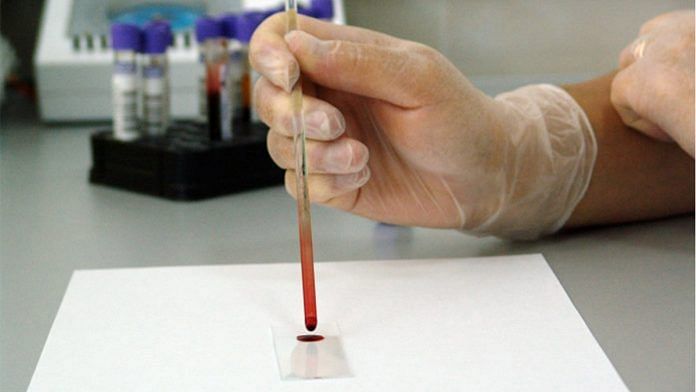New Delhi: Increased screening, better treatment and including the Human Papillomavirus Vaccines (HPV) in the National Immunisation Programme are some of the ways in which India can eliminate cervical cancer, according to experts.
At a webinar organised by Harvard University’s T.H. Chan School of Public Health and health data portal Project Sanchar Tuesday, a panel of health experts discussed the most effective preventive measures and treatment for cervical cancer in India.
Cervical cancer is caused by the human papillomavirus, which is transmitted sexually, and occurs in the cervix or lower part of the uterus.
“In India, we have almost 100,000 new cancer cases and about 68,000 cervical cancer deaths in 2018, which constitutes almost a sixth of the global total of the disease in the world,” said Dr Rengaswamy Sankarnarayanan, senior visiting scientist at WHO (World Health Organization)-IARC (International Agency for Research on Cancer).
On a more hopeful note, he added, “There is considerable variation in disease occurrence within India. Kerala, for instance, has an incidence rate of less than 6 per 100,000 and the WHO threshold for elimination is four or less than four per 100,000. So, if such states take action now, elimination can happen very quickly.”
Also read: 6 in 10 diabetics in India worry about catching Covid, getting hospitalised, study finds
3 key steps against cervical cancer
Cervical cancer is the fourth most common cancer in the world and according to WHO, if no action is taken then the annual number of new cases is expected to increase from 5,70,000 to 7,00,000 between 2018 and 2030, while the annual number of deaths is projected to rise from 3,11,000 to 4,00,000.
In light of these figures, the WHO Tuesday launched the “Global Strategy to Accelerate the Elimination of Cervical Cancer” — the first-ever such resolution to eliminate cancer.
The global health body highlighted three key steps to effectively eliminate cervical cancer — screening, vaccination and treatment.
Sankaranarayanan and the other panelists at the webinar — including Neerja Bhatia of AIIMS, Dr Bakul Parekh of the Indian Academy of Pediatrics, and Cancer Foundation of India founder Maqsood Siddiqi — noted that India faces shortfalls in all the three areas.
Stressing on the issue of lack of vaccination, Parekh said, “The vaccine has been included in IAP (Indian Academy of Pediatrics) but not in the National Immunisation Programme. Now there are two vaccines, which have been approved by IAP and are being used in private clinics. But the cost forms a very big barrier. And if the governments help, it can be a big leap.”
He added that the timely implementation of the vaccine can prevent 1 lakh cervical cancer cases and 60,000 deaths.
“Vaccination is a public service, you have so many vaccines under the immunisation programme, which are provided by the government with appropriate logistics and infrastructure. This (HPV) vaccine has to be provided as a public service and this is not happening in most states in India,” Sankaranarayanan said.
Also read: 455 million people get this disease every year. But no one talks about it
Screening and treatment
In the case of cervical cancer, the most recommended prophylaxis or treatment to prevent the disease is regular screening through the Papanicolaou (Pap smear tests) or the HPV test.
A Pap smear test involves the examination of cells from the cervix while the HPV test, which also requires swab samples from the cervix, identifies the high-risk types of the virus that can cause most cervical cancer.
Bhatia, who heads the department of obstetrics and gynaecology at AIIMS, also noted that women tend to come in for screening when the disease is already in an advanced stage and indicated that this could be caused by the stigma against the cancer, even within the medical community.
“There’s a tendency amongst the clinic supervisors to say oh these are the HIV patients, we will finish the normal ones first before we do them. So a stigma kicks in at many places and you have to deal with that,” she said.
“The day we start doing this screening on a regular basis, we will probably find them at least 10 years earlier, and in an earlier stage of the disease. Now we have this national programme, which has been operationalised in some districts, but we have a long way to go,” Bhatia added.
She was referring to the population-based cervical cancer screening programme that was launched by the health ministry in 2016.
Meanwhile, on the issue of the lack of inadequate treatment against cervical cancer, both Bhatla and Sankarnarayanan stressed on the need for more infrastructure.
“For the surgery, the facilities are available only at tertiary centres established for cancer. These may be regional cancer centres or medical colleges and then of course, we have the private cancer hospitals as well. But typically, people in rural areas have to travel a distance to access them,” the AIIMS doctor said.
Sankaranarayanan added, “If you take radiotherapy facilities…we have around 684 external radiotherapy machines out of which half of them are about machines and half of them are linear accelerators and about 350 brachytherapy units, so you can understand how woefully inadequate it is.”
Radiotherapy or radiation therapy uses high doses of radiation to shrink cancer cells and tumours. It is the most common way of treating cancer.
“There needs to be vertical investments into this because accessing radiotherapy in private sector is highly expensive,” he said.
Also read: Exploring ayurveda for cancer treatment — the 2+2 India-US pact you didn’t hear about



